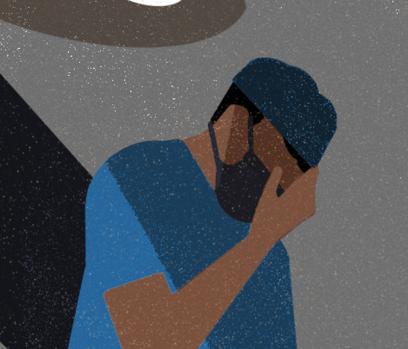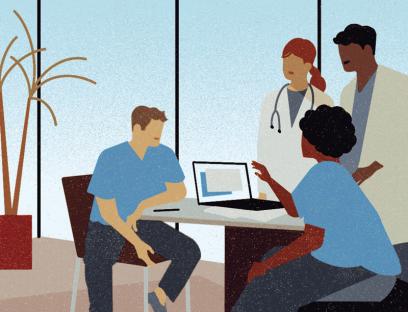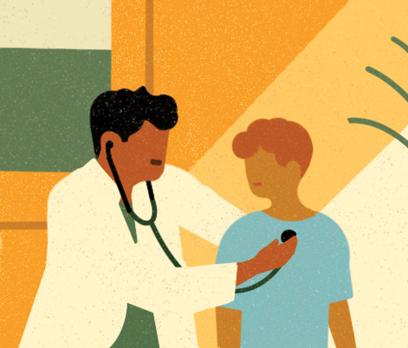When I was a child, I dreamed of being a doctor. I wanted to provide care to the sick and injured. That’s part of why, many years later, I chose to specialize in emergency medicine. I wanted to be able to see anyone, anytime, with any problem, regardless of their ability to pay. Serving my community in that way felt like a higher calling.
I entered medicine with a certain level of idealism, and while more than a decade of experience has tempered it in some ways, those values still drive me. That’s why seeing this profession that I have held in such high regard be demeaned by pressure toward corporatization has been so disheartening. Healthcare workers are essentially being transformed into cogs in a profit-making industry at the expense of patient care and at the expense of the people who have given years of their lives to train for a purpose. That was a big part of why my colleagues and I organized the clinicians at PeaceHealth’s Eugene-Springfield urgent care facilities.
Building a Community and a Career
Community and family have always been at the heart of my medical practice and at the heart of the choices I’ve made about how I practice. My extended family lives in Medford and Oakridge, Oregon, and I graduated medical school from Oregon Health and Science University, so returning to Oregon in 2016 after I finished my residency in Pittsburgh felt like a natural choice. My husband and I moved back and started putting down roots, and it’s been a joy to grow our family here.
When we had our first child, I found that the schedule of an emergency physician disagreed with the needs of my family, so I transitioned into urgent care in 2018. That’s when we came a couple of hours south to Eugene, where I began working at PeaceHealth’s West Eugene urgent care clinic. PeaceHealth was an appealing employer because it is the only urgent care provider in the community that accepts Medicaid. Other urgent care clinics in the Eugene-Springfield area only take online appointments and do not accept Medicaid, so people with low incomes and those without internet savvy get shut out. At PeaceHealth, I felt I could continue seeing everyone regardless of their status and live into my values.
Initially, working at PeaceHealth was just what I was looking for. We had a very strong team with clinicians who had been there for a long time. We were a much-needed support for both the primary care clinics and the emergency department (ED). But retirements happen, and people move. Then the pandemic came, and we found that while our numbers were starting to dwindle, staff were not being replaced at the same rate.
In late 2020, we started sounding alarms to our managers and to our administration, especially because they had the power to open up positions and hire people. But the response was lackluster. We continued to lose staff, and it turned into a serious crisis in late 2021 as people started leaving in protest because their concerns were not being addressed. PeaceHealth had named us the 2020 Clinic of the Year, yet the administrators were allowing our clinic to wither. With high turnover and a lengthy onboarding process (about six months), administrators should’ve taken a long view of where the workforce was and where they wanted it to be. But instead of getting out in front of this clear problem, PeaceHealth watched the provider group shrink to a third of its former size. Worse, it refused to offer per-diem contracts to departing clinicians, even when they expressed interest (and even though we already had some clinicians on such contracts).
A Mounting Crisis
When I joined PeaceHealth, we offered urgent care at three locations—West Eugene (my clinic), Gateway, and Valley River—plus some limited services at the Woodfield Station walk-in clinic. Before COVID-19, each clinician could see 30 patients on a busy shift, such as during the height of the flu season; with three clinicians, we could see around 200 patients a day among us across the four clinics. COVID-19 changed how we approached patients, especially in terms of the personal protective equipment we had to use, and for a time the demand for non-COVID-related concerns decreased. But patient numbers picked up again in 2021. We found ourselves unable to meet the renewed demand: Valley River had to close in fall 2021, then the Gateway clinic in November 2022, because we couldn’t keep enough providers. So two-thirds of our urgent care clinics have closed in response to continuing deteriorating staffing, which is a serious blow to the community.
These closures affect more than just wait times in our clinic. We have heard from our ED physician colleagues that the census of low-acuity patients, people who could have been seen by us, has gone up. According to one figure, the number of those patients doubled in the ED after Gateway closed. I have also seen patients who developed preventable complications—such as wound infections and simple urinary tract infections that turned into kidney infections—days after they were turned away from our clinic.
We have wonderful staff who are all committed to making sure our patients receive excellent care, even under these circumstances. Our patient access representatives who staff the front of the clinic are trained to recognize red flag symptoms like chest pain, stroke-like symptoms, or abdominal pain in pregnancy. Our nurses effectively triage these patients, and in many cases, patients can be redirected to the ED if they are stable and there is nothing meaningful we can do for them. But a few will need stabilizing care and safe transport to the ED, and then one of us will drop what we’re doing to attend to the emergency.
Frequent task-switching becomes burdensome when we find ourselves working as solo providers, which was a serious problem when we were most short-staffed. Procedures and conversations get interrupted, adding to the frustration of our patients. Wait times become egregiously long, and some patients take their frustrations out on our staff.
The overwhelming demand also puts a strain on us when we get only 30 minutes for lunch in an 11-hour shift. And it can be hard to find time to stay hydrated or take a bathroom break when you’re trying to see three patients an hour and some of them need breathing treatments, x-rays, or additional testing. In spite of these challenges, I have remained determined to meet the needs of my patients; I can’t just steamroll through them like they’re assembly line products. I wouldn’t want that for my family.
PeaceHealth’s Failed Response
PeaceHealth’s administrative response to the closure of the Valley River clinic only made these problems worse. The administration unilaterally rolled out an “Urgent Care Recovery Plan” in late March 2022 to address census and “productivity” issues.
One of those changes involved mandating that we see, evaluate, and bill every patient who walked in through our doors, regardless of whether they were appropriate for our clinic. People with clearly complex injuries, pregnant people with abdominal pain, and people with stroke symptoms that we were not equipped to evaluate, who all should have been triaged immediately to the ED, would suffer the double injury of delayed care and an extra medical bill. We found that to be exploitative, unethical, and harmful.
Another policy instituted without our buy-in disallowed us to close a clinic based on our capacity. So an unlucky clinician working solo might find themselves staying hours past the end of their scheduled shift to see every patient still in the waiting room. Eleven-hour shifts became 13-plus hours—we could no longer tell our families when we’d be home. It was instantly demoralizing. Per-diem providers who had previously worked regularly, even covering for clinicians who were ill, abruptly stopped taking shifts. Others simply looked for work elsewhere.
I can understand why my colleagues may be actively looking for other jobs. When every day can be a battle and hope for meaningful improvement remains in the distant future, the motivation to stay can be hard to maintain.
Organizing for Patient Safety
PeaceHealth’s distressing decrees prompted us to take collective action. We were not willing to endanger our patients or sacrifice our families so that PeaceHealth could increase its profits.
In April 2022, my clinician colleagues and I had a meeting to discuss the policy changes. I had brought my laptop to this meeting, and together we composed a letter signed by 85 percent of the clinicians affirming the values we were committed to and the practices that we would refuse to abide. It informed the administration that we would continue to act in the interests of our patients before profits. (Read the letter here.)
After receiving the letter, the administration compromised on triaging patients but did not initially relent on the issue of clinic closure due to being over capacity. Their decision made it clear that real change could only be secured by forcing them to bargain with us—and that meant unionizing.
To be honest, I didn’t think unionizing was a possibility in March 2022, even though it was something I supported. Then I heard that the PeaceHealth hospitalists had unionized at Sacred Heart in 2015, so I contacted the hospitalist founder, David Schwartz, and set up a Zoom meeting with our team so we could talk about our concerns. He told us about his experience and put us in touch with the AFT organizer who had helped him.
We chose to form PeaceHealth Providers United as a new bargaining unit of the hospitalists’ union, the Pacific Northwest Hospital Medicine Association. The Woodfield Station walk-in clinic joined with us because we provide similar services and there has been a lot of cross-coverage between our locations—when they need a clinician, oftentimes one of us will cover, and vice versa. And with only two full-time clinicians at Woodfield, stabilizing working conditions and staffing is critical.
The AFT’s organizing staff was really helpful in leading us through the process of gathering signatures on authorization cards and rolling out the voting campaign. We had a lot to learn about unionizing, our legal rights, and the importance of a clear mission statement. The signature collection took place in late May and early June 2022; by early July, we had our election scheduled. The ballots (we did vote by mail) were counted on August 18, 2022, and the result was unanimous.
Claiming Our Seat at the Table
We’re now waiting for complete information about PeaceHealth revenues and expenses as we prepare for contract negotiations. We hope we’ll be able to right some of the wrongs, such as increasing pay for advanced practitioners so we can recruit and retain the best providers. If other urgent care facilities can afford to pay their advanced practitioners the market rate, so can PeaceHealth. Money that has been paid to bring in expensive temporary providers could be used instead to retain the experienced local workforce we have.
Fundamentally, we want changes that will stabilize our staffing and contractually secure basic working conditions, such as specified shift lengths. I would like to see us reopen some clinics, too. This last year has been terrible for respiratory viruses. Some of the patients I see thank me for being there or apologize about how busy it is, but it is the patients’ experience that has changed the most—they used to be able to walk in and be seen within two hours, and now wait times are far longer. That some will still wait six hours to be seen is a testament to the desperate need for care.
Despite our struggles, PeaceHealth doesn’t seem to be working hard to prioritize recovery for us. In December 2022, it only had two open positions advertised on its website for urgent care in Eugene: one physician and one physician assistant (PA). Why hasn’t PeaceHealth opened more of those vacant positions? Why were departing providers who were interested in per-diem contracts not given them? Why is the base pay for our PAs and nurse practitioners (NPs) still significantly below the current market average? And why do our executives earn bonuses amid this failure?
PeaceHealth has chosen to play games, attempting to deny us our annual base pay increase after we unionized. We were able to call out this unfair labor practice immediately, and within a few weeks PeaceHealth relented, but not before losing yet another NP who had been hired only three months before.
Putting My Values and My Patients First
When I interviewed for PeaceHealth in 2018, I told them that I wanted to join a place where I could stay, and that’s still my intention. I’ve worked at different places, and I know that for an emergency physician, what’s out there for me in Oregon is a lot of independent contracting positions that offer even fewer protections to me as a worker. I’m certainly not eager to uproot my family either.
I work hard, seeing as many patients as I can. Yes, work is hectic, but I’m not the one being asked to wait for six hours to be seen for an illness. I know I can leave if I want, but what I will find in another large health system or contract medical group is the same thing: a relationship based on extracting maximum value for minimum expense. Here, I have a chance to be a part of something new, to actually work in a unionized clinic. That’s something I never thought was possible when I became a physician. Not only can we make this a really special place to work and a great place to be a patient again, but the standards we establish can also start to put pressure on other clinics to create positive changes.
A New Paradigm for Physicians
Many physicians are not used to thinking of themselves as part of labor. I did see myself as a worker because emergency physicians traditionally have done shift work in hospitals. But for much of modern history, physicians have owned their own practices or worked in hospitals with physician CEOs, so decision-making at the executive level was informed by best medical practices. However, as healthcare has been transformed by corporate America in the last several decades, that model is becoming rarer.
Now, healthcare systems are increasingly modeling their behavior on for-profit corporations. Their concern is increasingly with the bottom line and with extracting more labor from fewer workers. We physicians need to recognize that we are seeing our role deprofessionalized, like many other professions and trades have been transformed in the industrial era. To meet the needs of our patients and to protect our profession from being degraded any further, we have to step up and organize.
I want to see this union succeed because I want to take this message to other people. I see clinicians sharing on social media about the despair they feel working for what feels like a sickness-billing industrial complex, and I want to show them that something better is possible. I don’t think unionization will solve every problem—for example, I think we also need Medicare for All to get rid of the insurance profit motive—but it’s important to give power over how hospitals and clinics are run back to clinicians.
Unfortunately, our healthcare system has become enthralled to a cult of efficiency, sacrificing resiliency at every level. And that hyperfocus on efficiency has consequences. We see it reflected in systems like Ascension Health, which (according to a New York Times investigation*) continued to cut staff as it raked in billions in profits. And we see it reflected at the individual level as clinicians burn out, leave their professions, and even die by suicide. We see patient care sacrificed as patient-nurse ratios get pushed higher in the hospital setting. I saw it a few months ago as we were hit by one of the worst respiratory viral seasons I have ever witnessed, and we had to turn away dozens of patients each day for lack of staff.
With higher union density across the healthcare system, those bare-bones, “efficient” staffing levels can be changed. And that leads to better patient care, better outcomes, and better morale among healthcare workers. This in turn translates to better healthcare worker retention and less utilization of expensive and climate-costly travel nurses and clinicians. And we can have better support. The nurses at the Eugene hospital succeeded in creating a committee for workplace violence, which we also encounter in urgent care. Our union plans to address that, too.
To other physicians who have thought about organizing, I want you to know that it’s worthwhile, it’s possible, and it can be easier than you think. The first step is just to contact a union representative and start asking questions. If you find yourself complaining to your colleagues about working conditions in almost every conversation you have with them—and especially if they’re voicing the same concerns—then it’s time to organize. If there’s a common reason people are looking for other work, take action around it. Having at least one concrete issue to rally around is essential. For us, it was being able to say, “No, I will not make a patient wait for me and then bill them for simple triage advice if they have an emergency medical condition beyond my ability to treat because that is antithetical to my oath.” It wasn’t like everyone was itching to unionize before that. We started with a letter, but now we’re standing alongside the 1.7 million members of the AFT. We created our own seat at the table, and we’re looking forward to bargaining our first contract.
Morgan Garvin, MD, is a board-certified emergency medicine physician in Eugene, Oregon. She is a founding member of PeaceHealth Providers United.
*R. Robbins, K. Thomas, and J. Silver-Greenberg, “How a Sprawling Hospital Chain Ignited Its Own Staffing Crisis,” New York Times, December 15, 2022. (return to article)
[Illustrations by Andrea Mongia]




